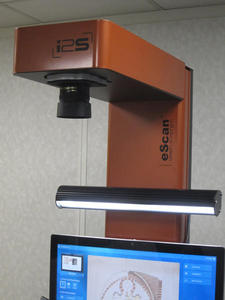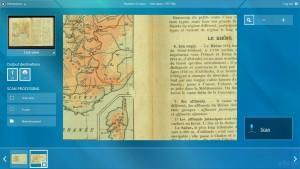Customer testimonial

18 eScan Open System scanners installed at National Library of France
To increase the accessibility of knowledge to all, the National Library of France decided to facilitate cultural heritage access to its public.
Photocopiers were used by the public library’s community of members. However, the library recognised limitations with the use of photocopiers: old or bound books were damaged or quickly wore out (copying face down, crushing pages and binding) and users couldn’t view what is printed or scanned, resulting in rescans or incomplete images. It was clear that capturing images from above would be most suitable technique. Therefore, in 2009 the National Library of France became one of the first public institution in the world to equip themselves with eScan book scanners for replacing photocopiers.
|
| Through outsourcing company Sedeco, the National Library of France was equipped first – in 2009 – with 12 first-generation eScan book scanners: the first self-service book scanner on the market. The eScan book scanners were easy to use and ergonomic; however, most importantly, the scanners could provide high-quality images for old or historic texts, books and other documents in the National Library’s collection. Installed at 4 sites of the National Library of France, the 12 scanners allowed the public to request a local operator to make a high-quality copy of an excerpt of a work and then print the document (single output mode authorized by the institution at that time). With the success of its service, the National Library of France decided in 2014 to review its requirements and refresh its technology: this resulted in an increase of the number of scanners. Appreciating the features already existing in the eScan first generation scanners, the library updated its capabilities and access of the new eScan Open System book scanners by enabling some scanners to be directly accessed by readers (“self-service book scanning”). |
To accommodate both public users and to enable scanning for a wide range of works in their collection, the required criteria for choosing a scanner were:
- Real time preview
- Scanning area up to 560 x 400 mm (22” x 15.7”)
- Multiple outputs: Printing (book scanner connected to any printing machine) and back up on any USB key existing on the market
- Direct pay for copies (whereby the book scanner was connected to a card reading machine)
- Digitizing in color or in grey
|
Interface Limb Capture Self-Service installé sur eScan Open System pour numériser en toute tranquilité |
Despite the evolution of smartphones’ performances and strong competitors with alternative book scanning solutions, i2S and its partner Spigraph Network again earned the confidence of SEDECO and installed 18 of the next-generation eScan Open System book scanners at the same four sites of the National Library of France. Nine of the scanners – installed at the Tolbiac site- were fully enabled for customer self-service scanning.
What made the difference: i2S distinguishes itself from all its direct and indirect competitors through:
- Image quality offered by the i2S camera,
- Real time preview in color, highly appreciated (essential and convenient) by users for missing no scan,
- Large scanning area (560 x 400 mm)
As the leading i2S partner in EMEA and with over 20 years of industry experience in providing book scanning solutions, Spigraph Network manages both the business relationship with Sedeco and provides post-installation support with warranty service and maintenance of installed scanners.
A variety of works are digitized with eScan Open System, including:
- Tolbiac site (François Mitterrand) : printings from XVIth to XXIth centuries, 700 000 volumes, 10 000 000 books and 350 000 periodical titles, 385 000 linear meters of book shelving
- Richelieu site : + 10 000 medieval manuscripts, 2 700 000 volumes of divers printings (books, periodicals and collections), manuscripts and documents from performing arts, 1 600 000 cards and plans, 12 000 000 drawings and photographies, 1 220 000 Western and Eastern manuscripts
- Arsenal site: library specialized in literature and History, 7 000 books in self-service and a collection including thousands of periodicals, drawings, manuscripts, cards and sheets music
- Opéra site : museum-library specialized in music including also Opéra de Paris archives and Dancing international archives, preserving near 600 000 divers documents (books, periodicals, sheets music, booklets, programme brochures, drawings etc.)
source : Wikipedia











